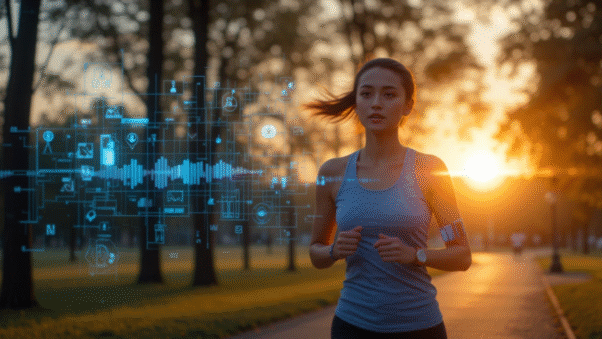How Technology Has Changed Our Activity Levels
Technology has dramatically changed the way we move, exercise, and manage our daily activity. From wearable devices that count every step to mobile apps that provide guided workouts, our activity levels are now closely connected to digital tools.
But has this shift made us healthier or more sedentary? In this article, we explore how innovations like wearables, AI coaching, and virtual fitness programs are shaping our movement, the pros and cons of these changes, and practical tips to use technology for a healthier, more active lifestyle.
1. Wearable Devices: Tracking Every Step
Wearables such as smartwatches and fitness trackers have become essential tools for monitoring physical activity. Devices from Apple, Fitbit, Garmin, and others record steps, heart rate, calories burned, sleep patterns, and even oxygen levels.
By giving users real-time feedback, wearables encourage healthier choices: taking the stairs, walking more, or scheduling regular exercise sessions. According to recent studies, people who consistently use wearable devices are more likely to meet daily activity goals and maintain long-term fitness habits.
Key benefits of wearables:
- Step tracking and distance measurement
- Heart rate and calorie monitoring
- Sleep quality tracking
- Reminders to move or stand
2. Mobile Apps: Personalized Activity Plans
Fitness and wellness apps are another major technology influence on activity levels. Apps like MyFitnessPal, Nike Training Club, and Strava offer personalized workout plans, progress tracking, and motivational features. Users can select workouts based on fitness level, goals, and time availability.
Apps also allow social integration, connecting friends for challenges, which increases accountability and motivation. Gamified features, like badges and rewards, further encourage daily movement and consistency.
Example features:
- Daily step and workout goals
- Video-guided exercises
- Progress tracking and analytics
- Virtual communities for motivation
3. AI and Virtual Coaching

Artificial intelligence has taken fitness personalization to the next level. AI-powered platforms analyze your activity data to provide tailored recommendations and predict optimal workout plans. Virtual coaches adapt routines in real time based on progress, fatigue, and lifestyle factors.
For instance, some AI apps suggest the intensity, duration, and type of exercise best suited for a user on a given day. Others even combine diet insights with activity plans, ensuring holistic wellness.
Benefits of AI coaching:
- Highly personalized workout plans
- Real-time feedback and adjustments
- Integration with nutrition and wellness tracking
- Motivation and accountability through virtual reminders
4. Sedentary Risks of Technology
While technology encourages activity in some ways, it also contributes to inactivity. Excessive screen time, remote work, and entertainment apps can reduce overall movement.
People may spend hours sitting with smartphones, laptops, or gaming consoles, which negatively affects cardiovascular health, posture, and metabolism.
Tips to counter sedentary behavior:
- Use reminders to stand or stretch
- Take short walking breaks during screen time
- Combine entertainment with movement (e.g., fitness gaming, dance apps)
5. Gamification and Social Motivation
Gamification—adding game-like elements to fitness—has proven to boost activity levels. Apps and wearables often use leaderboards, badges, and challenges to encourage movement. Social motivation, such as competing with friends or joining online communities, increases engagement and consistency.
Popular examples:
- Step challenges among friends on Fitbit or Apple Health
- Running clubs on Strava
- Virtual reality fitness games like Beat Saber or Supernatural
Gamified approaches make exercise feel fun rather than obligatory, which helps sustain long-term activity.
6. Future Trends in Activity Technology
Technology continues to evolve, offering new ways to stay active:
- VR and AR Workouts: Immersive fitness experiences that combine gaming and exercise.
- Smart Clothing: Wearable sensors embedded in clothes track posture, movement, and muscle activity.
- AI-Integrated Homes: Smart home gyms with personalized training guided by AI.
- Health Data Analytics: Advanced apps predicting injury risks and suggesting preventive exercises.
These innovations promise to make staying active more convenient, enjoyable, and tailored to individual needs.
7. Balancing Technology Use for Better Activity Levels

To maximize benefits, it’s essential to use technology mindfully:
- Set realistic goals and monitor progress without obsessing.
- Schedule “tech-free” active time outdoors.
- Combine digital tools with traditional exercise like walking, cycling, or swimming.
- Regularly review data from apps and wearables to adjust routines.
By striking the right balance, technology can enhance your activity levels rather than hinder them.
Conclusion
Technology has transformed the way people approach activity and fitness. Wearables, apps, AI coaching, and gamified challenges have motivated millions to move more and improve their health. Yet, it’s also important to manage screen time and sedentary habits.
Used wisely, technology is a powerful ally in boosting daily activity, improving wellness, and creating sustainable healthy habits. The future promises even more innovative solutions that make staying active fun, personalized, and effective.
FAQs
Q1: Can wearable devices really increase daily activity?
Yes, studies show that real-time feedback, reminders, and goal tracking motivate users to move more consistently.
Q2: How do AI fitness apps personalize workouts?
They analyze user data such as activity level, progress, and health metrics to create adaptive, tailored exercise plans.
Q3: Can technology help prevent sedentary lifestyle risks?
Yes, reminders, gamified challenges, and movement prompts encourage regular activity and reduce prolonged sitting.
Q4: Are virtual workouts as effective as traditional exercise?
When properly followed, VR and AR workouts provide comparable cardiovascular and strength benefits, with added engagement and motivation.
Q5: How can families use technology to stay active together?
Family challenges, shared fitness apps, and interactive games encourage group activity, making movement fun and social.

